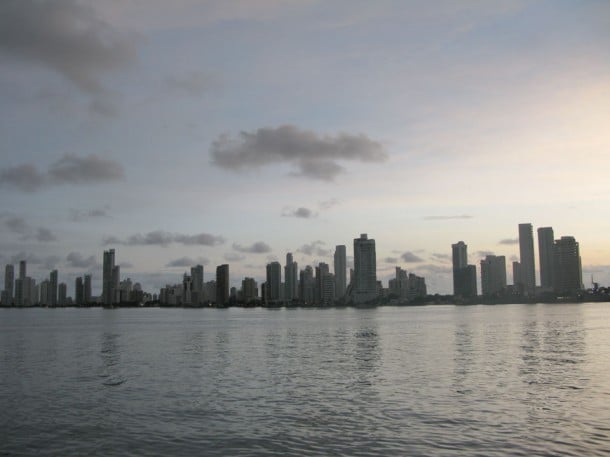
Tourist Towns – we’ve all been to one. These are the places where we’re herded in groups through areas that found their way onto the well-worn tourist track. These places are recognizable by their parking lots for tourist buses, sunburnt tourists and the “local” restaurants that have menus in seven different languages.
Cartagena, a picture-perfect city on the Northern coast of Colombia could easily fall into the “tourist town” category, but somehow it eludes this grim fate and charms even the most jaded tourist. Sure, Cartagena has plenty of tourists, as well as hostels, backpackers and tourist traps. But the city offers plenty of magic and a culture that runs deep. Overlooking the Southernmost portion of the Caribbean, Cartagena is a city of nearly 1.2 million people that manages to combine the best of the Caribbean lifestyle (beaches!) with a fascinating history (pirates!) and plenty of romance (horse-drawn carriage ride, anyone?)

GETTING YOUR BEARINGS
Cartagena is an easier getaway than you may think. The city is a 2.5 hour direct flight from Miami on Avianca, the Colombian carrier. Once you arrive, you’ll probably notice the heat first. With temperatures reaching into the upper 80s Fahrenheit for most of the year, the heat and humidity set the scene, constantly reminding you to slow down and enjoy an ocean breeze. The most popular parts of the city are the walled historic center, Getsemani, and the new city, a newly developed beachfront area that has a frightening resemblance to Miami Beach, with condos and resorts.
WHERE TO STAY AND GETTING AROUND
For first-time visitors, the historic center is a great spot to settle – it’s a UNESCO World Heritage Site, there are plenty of charming hotels and it’s easy to explore by foot. And while a trip to the public beaches is a short taxi ride away (8 minutes to Boca Grande beach; $5-$7), the atmosphere of the historic center is why you’re here.
Once you’re settled, the best way to explore is by foot, allowing yourself to get lost among the maze of the city streets. If you have the time and the budget, consider a bike tour, a boat ride or a horse-drawn carriage ride. I stayed at the Hotel Charleston Santa Teresa which is a luxury property with water views, contemporary rooms (each room comes with an iPad) and a stunning rooftop pool and bar. Rooms start at $299 a night.

COLOMBIAN FOOD
Colombians love to eat, and it’s not hard to find great restaurants at all price points. The balmy climate ensures fresh fruits and vegetables year-round. Local fruits like lulas, corozos, mamoncillas are all delicious and easily available; it’s easy to find fresh fruit on sale on the street or served as luscious juices in most restaurants. While much of the food is fried (arepas seem to be available at every meal), there is a wide variety of flavors and nothing too spicy.
DINING OUT
My two favorite restaurants were on opposite ends of the budget spectrum, but both have charismatic chefs and a distinctly Colombian flavor.
Don Juan is a high-end restaurant manned by Chef Juan Felipe Camacho. He is at the forefront of the Latin American culinary movement and is creating contemporary interpretations of classic Colombian dishes. Try the grilled shrimp, but leave room for the pineapple dessert. Dinner for two with wine is about USD $100. La Cocina de Pepina is a more casual, less expensive spot in the Getsemani district that serves Colombian-Caribbean food. Executive Chef Maria Jose Guerra Yances left her career as a sociologist to become a chef, and the personal attention is evident in this cozy, 25-seat restaurant. Lunch for two with drinks is about $40. (No web site; Getsemaní, Callejon Vargas No. 9A-06; +57 315 655 4120)
More information on Colombia here.
This trip was sponsored by Proexport Colombia.









